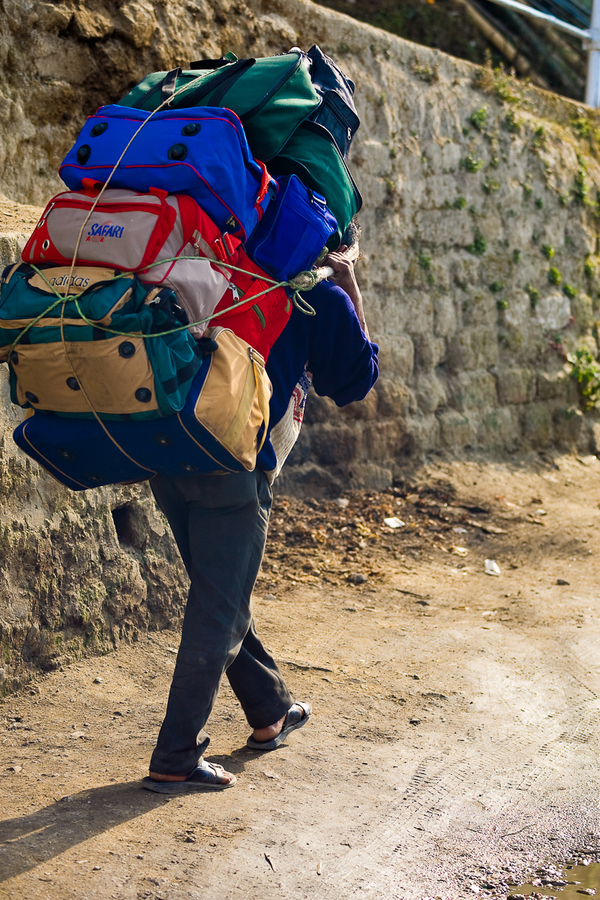Two traveler scams

When I traveled for business, sometimes on trips lasting weeks, my rule was no checked bags. The idea was to carry everything onto the plane with me such that there was no potential for lost bag nor need for checked bag retrieval. It was off the plane, out to the curb at arrivals and into the taxi or rental car shuttle.
Traveling light in this manner meant that I could comfortably carry what I had along, even run with it to catch a train.
Moving to Uruguay I started traveling with too much luggage. It started with the move. Here I was taking with me everything I wanted to keep in my life that was not in storage. It was more than I could carry, with two checked bags. One of them weighed more than I could comfortably walk with.
On trips out of Uruguay to England and to the United States I often left and returned with a little extra. On the way out, I’d bring gifts. On the way back, I’d bring purchases. Imported goods are expensive in Uruguay due to taxes and shipping distances. Uruguay has a healthy and modern economy and many resources, but it’s small; so, many things are imported.
Traveling with more bags than I can carry, or burdened with as much as I can carry; traveling long distances, on overnight flights with plane changes and lay-overs, on trips that stretch waking time and create jet lag with or without changes in time zone, I’ve found that I’m susceptible to scams on arrival. Vigilance is necessary when traveling, and traveling over-laden. It’s especially necessary on arrival, when I’m tired, a little high on having made it, and somewhat drunk from lack of sleep.

The mustard scam
This one got me. I had decided to hoof it with two heavy bags plus my computer bag between a bus terminal and ferry terminal in Buenos Aires. It was a daylight walk of about a kilometer (a thousand yards). Why take a taxi?
Hoofing it along at my usual rapid walk I pass a construction site. Something wet lands on my head. I look up while walking and don’t see anything. I ignore it and keep on hoofing. A little guy overtakes me talking rapidly in Spanish. He has to nearly run to overtake me, poor guy. He gets in front of me and gets me to examine the wet. It’s sticky. He offers some tissues and starts helping me to wipe it off, including some encouragement to drop my stuff on the sidewalk and start cleaning that up.
He’s quite the pro, distracting me with constant chatter and being so helpful with suggestions what to do, which I start following as he basically has me hypnotized. He separates me from my computer bag and has distracted me from noticing. He has me facing away from the street, and has me take off my fleece. Having done so, I look back and he’s gone. A taxi speeds away. I take stock. My computer bag is gone.
There are many variations on this, but the theme is to distract you with some minor accident and behave as a good citizen trying to help while separating you from some or all of your luggage. It is almost like purse snatching but without the necessary force nor necessity to run. By the time you notice, the thief and your luggage are out of sight.
Remedy
It’s harder than you think to resist the good citizen trying to help you sort out a small accident. You must. When you are outside a secure area with your luggage, you have to remain in contact with it at all times. You can’t watch it at all times. You have to remain attached to it. If it’s on a cart, you keep your hands on the cart.
The best thing to do is to call out loud like a lunatic, describing the situation, “Oh my god there’s mustard all over my shirt! This guy got mustard on my shirt! It’s sticky! It’s orange! Oh my god, this shirt is ruined! This guy spilled on me! Oh, he’s trying to help!” And so forth. The idea is to draw as much attention to yourself and your (possible) assailant as possible while reminding yourself to remain vigilant of your luggage and not be distracted nor start a distracting confrontation, nor really engage.
It’s extremely difficult not to default to truth, to believe the face of the situation– some little accident and a good Samaritan trying to help. Think of your luggage as if it’s a tender part of your body. Bring it closer. Don’t put it down. Don’t let it go. Deal with the little accident and your new friend by trying to get as many eyes on it, them, you, and your luggage as possible. Clean up later.
Keep this going. Loudly beg-off, “Oh my god, don’t worry about it. No problem. I’ll deal with it myself. No, don’t worry. It’s okay.” All at the same time gathering your things close and moving away.

The ride scam
This one almost got me, but I was saved. Taking a cab in a strange place, as a traveler, has always been fraught with danger. Hailing a cab is especially risky. This danger has improved with ride services but still requires the same care.
You have used the ride service app to solicit a ride. You’re standing at the designated pick-up point with your stuff. Unknown to you, someone watching the pick-up point has notified an accomplice to your presence. They pull up in a car as if they are your ride. You put your bags in the trunk, close it, and turn to put away the cart or simply move to open the back door to jump in.
In some scenarios, in some countries, you jump in and are kidnaped. More often the car simply speeds away out from under you. Before you know it, you’ve been separated from all of your luggage. Permanently.
It sounds far fetched that you would fall for this, but remember. You default to truth. You’re mentally impaired by fatigue. You have the distraction of being in an unfamiliar place. The advice is as follows:
- ask the driver to get out and help you load your bags. Most do so without your asking. You can do the same at the destination.
- ask them to put away the cart for you while you close the trunk and get in the car.
- with ride services
- always verify the license plate and at least the make of the vehicle to see that it matches. If there’s no match, don’t go. No matter what excuse the driver provides– no match, no go.
- the driver should know your name and destination. If they haven’t greeted you by name, as they’re trained to do, ask them who you are and where you’re going. If they don’t know, don’t go.
- most ride sharing app’s, including the most popular, fail to show you a picture of the driver that’s large enough to help you recognize them. It’s nice to greet them by name, but that they respond to the name is no indication that they are legitimately your driver and your ride.
- with taxis
- use a taxi stand if possible, or call a taxi service and get the medallion number of the car that will retrieve you.
- take a picture of the driver and the car with license plate before getting in. Send it to someone who knows where you are. If you don’t have a data connection, as can happen with un-subscribed or spotty cell service, this won’t help you.
- use ride sharing services, not taxis. They’re more secure unless you have used a taxi stand or called for the cab using a taxi service.
Using ride sharing app’s, it’s easy to become complacent, not to verify the identity of the car that pulls up. Yay! Here’s my ride! This is routine. We jump in and off we go. Don’t do this.